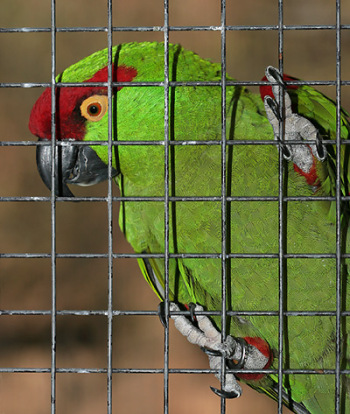In this post we return to The thorny issues of plant and animal trafficking and biopiracy in Mexico. We highlight several recent news items related to wildlife trafficking, as well as an important survey of the illegal parrot trade in Mexico.
Mexican police launched dozens of raids on stores and markets in March 2010, looking for illegally-traded plants and animals. They collected more than 4500 live specimens, representing more than 110 different species, ranging from cacti and orchids to tropical fish, parrots, reptiles and puma cubs. The mortality rate while transporting illegally-traded animals is more than 90%, according to wildlife experts.
The following month, Mexican federal police rescued 10 tigers and jaguars held captive in Cancún as a tourist attraction, while in June 2010, police at Mexico City’s international airport arrested a Mexican traveler who arrived from Peru with 18 tiny endangered monkeys strapped around his waist. Anyone convicted in Mexico of the illegal trafficking of animals can be sentenced to up to nine years in prison.
The scale of Mexico’s animal-trafficking problem is staggering. For example, according to the Defenders of Wildlife Mexico Program, “It is estimated that between 65,000 to 78,500 parrots are caught illegally every year.” (“The Illegal Parrot Trade in Mexico: A Comprehensive Assessment“)
The states with the worst records for numbers of parrots taken in the wild are Oaxaca and Chiapas (15,000 parrots a year each), Nayarit (12,500), Campeche (10,000) and Guerrero (5,000). Most of these parrots are thought to stay in Mexico, though up to 9,000 a year taken across the border into the USA.
Most of the trafficking in wildlife is carried out by organized international crime networks. Mexico is a major hub for the international trade in wildlife, both because of its rich biodiversity, and because of its proximity to the USA, one of the world’s largest markets for exotic plants and animals. The global trade in illegal wildlife is thought by Interpol to be worth $20 billion a year.
Related posts:
- Mexico’s mega-biodiversity
- The diversity of species (plants and animals) in Mexico
- Which areas of Mexico have the greatest biodiversity?
Chapter 5 of Geo-Mexico: the geography and dynamics of modern Mexico focuses on ecosystems and biodiversity. Chapter 30 analyzes environmental issues and trends including the impact of Old World species imported by the Spaniards, current environmental threats, and efforts to protect the environment. Buy your copy today to have a handy reference guide to all major aspects of Mexico’s geography!

Sorry, the comment form is closed at this time.